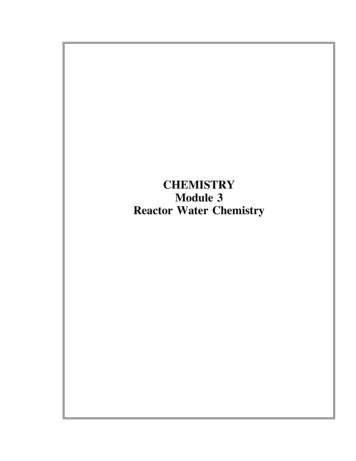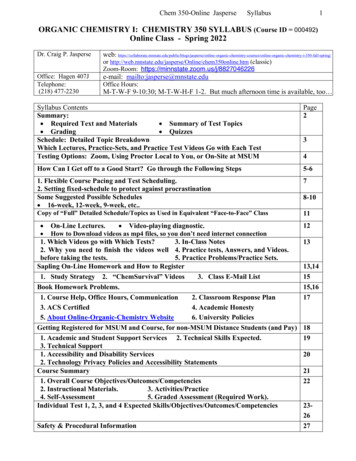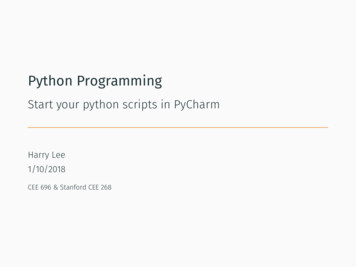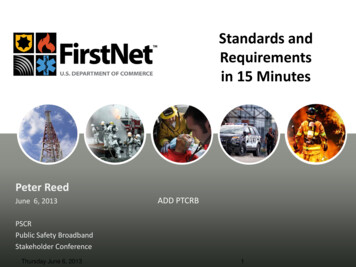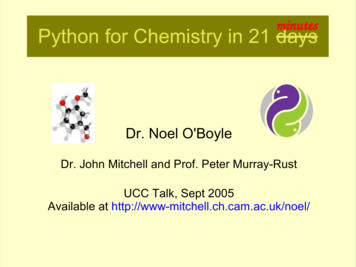
Transcription
minutesPython for Chemistry in 21 daysDr. Noel O'BoyleDr. John Mitchell and Prof. Peter Murray-RustUCC Talk, Sept 2005Available at http://www-mitchell.ch.cam.ac.uk/noel/
Introduction This talk will cover–what Python is–why you should be interested in it–how you can use Python in chemistry
Introduction This talk will cover–what Python is–why you should be interested in it–how you can use Python in chemistryThis talk will not cover– how to program in PythonSee references at end of talkWord of warning!!
“My mental eye could now distinguish larger structures, ofmanifold conformation; long rows, sometimes more closelyfitted together; all twining and twisting in snakelike motion.But look! What was that? One of the snakes had seizedhold of its own tail, and the form whirled mockingly beforemy eyes. As if by the flash of lightning I awoke.Let us learnto dream, gentlemen”Friedrich August Kekulé (1829-1896)
What is Python? For a computer scientist.–a high-level programming language–interpreted (byte-compiled)–dynamic typing–object-oriented
What is Python? For a computer scientist.–a high-level programming language–interpreted (byte-compiled)–dynamic typing–object-orientedFor everyone else.–a scripting language (like Perl or Ruby) released byGuido von Rossum in 1991–easy to learn–easy to read (!)
What is Python? For a computer scientist.–a high-level programming language–interpreted (byte-compiled)–dynamic typing–object-orientedFor everyone else.–a scripting language (like Perl or Ruby) released byGuido von Rossum in 1991–easy to learn–easy to read (!)–named after Cambridge comedians
The Great DebateSir Lancelot:We were in the nick of time. You were in great Perl.Sir Galahad:I don't think I was.Sir Lancelot:You were, Sir Galahad. You were in terrible Perl.Sir Galahad:Look, let me go back in there and face the Perl.Sir Lancelot:No, it's too perilous.(adapted from Monty Python and the Holy Grail)
Why you should be interested (1) Python has been adopted by the cheminformatics communityFor example, AstraZeneca has moved some of its codebasefrom 'the other scripting language' to PythonJob Description – Research Software Developer/Informatician[section deleted]Required Skills:At least one object oriented programming language, e.g., Python, C , Java.Web-based application development (design/construction/maintenance)UNIX, UNIX scripting & Linux OSPosition in AstraZeneca R&D, 02-09-05
Why you should be interested (2) Scientific computing: scipy/pylab (like Matlab) Molecular dynamics: MMTK Statistics: scipy, rpy (R), pychem 3D-visualisation: VTK (mayavi) 2D-visualisation: scipy, pylab, rpy coming soon, a wrapper around OpenBabel cheminformatics: OEChem, frowns, PyDaylight, pychem bioinformatics: BioPython structural biology: PyMOL computational chemistry: GaussSum you can still use Java libraries.like the CDK
scipy/pylab from scipy import * from pylab import * a arange(0,4) a[0,1,2,3] mean(a)1.5 a**2[0,1,4,9] plot(a,a**2) show() a - seq(0,3) a[1] 0 1 2 3 mean(a)[1] 1.5 a**2[1] 0 1 4 9 plot(a,a**2) lines(a,a**2)R
ster: information theory functions (currently, vq and kmeans)weave: compilation of numeric expressions to C for fast executioncow: parallel programming via a Cluster Of Workstationsfftpack: fast Fourier transform module based on fftpack and fftw whenavailablega: genetic algorithmsio: reading and writing numeric arrays, MATLAB .mat, and MatrixMarket .mtx filesintegrate: numeric integration for bounded and unbounded ranges. ODEsolvers.interpolate: interpolation of values from a sample data set.optimize: constrained and unconstrained optimization methods androot-finding algorithmssignal: signal processing (1-D and 2-D filtering, filter design, LTIsystems, etc.)special: special function types (bessel, gamma, airy, etc.)stats: statistical functions (stdev, var, mean, etc.)linalg: linear algebra and BLAS routines based on the ATLASimplementation of LAPACKsparse: Some sparse matrix support. LU factorization and solvingsparse linear systems
Scipy statistical functions descriptive statistics: variance, standard deviation, standard error, mean,mode, mediancorrelation: Pearson r, Spearman r, Kendall taustatistical tests: chi-squared, t-tests, binomial, Wilcoxon, Kruskal,Kolmogorov-Smirnov, Anderson, etc. linear regression analysis of variance (ANOVA) (and more)
pylab
pychem: Using scipy for chemoinformatics Many multivariate analysis techniques are based on matrixalgebrascipy has wrappers around well-known C and Fortrannumerical libraries (ATLAS, LAPACK)pychem can do:–principal component analysis, partial least squaresregression, Fisher's discriminant analysis–clustering: k-means, hierarchical (used Open Sourceclustering library)–feature selection: genetic algorithms with PLS–additional methods can be added
Python and R Advantages of R:– a large number of statistical libraries are availableDisadvantages of R:–difficult to write algorithms–slow (most R libraries are written in C)–chokes on large datasets (use scan instead of read.table)Reading in dataPrincipal component analysisMethod300K600K1.6MPython6.813.941R (read.table)42105R (scan)92056Method300K600K1.6MPython2.23.642R (read.table)510R (scan)3529http://www.redbrick.dcu.ie/ noel/RversusPython.html
Python and R rpy module allows Python programs to interface with R have the best of both worlds–access to the statistical functions of R–access to the numerous modules available for Python–can program in Python, instead of in R!!Python from rpy import r x [5.05, 6.75, 3.21, 2.66] y [1.65, 26.5, -5.93, 7.96] print r.lsfit(x,y)['coefficients']{'X': 5.3935773611970212,'Intercept': -16.281127993087839}R x - c(5.05, 6.75, 3.21, 2.66) y - c(1.65, 26.5, -5.93, 7.96) lsfit(x, y) coefficientsInterceptX-16.281128 5.393577
Python and RProblem: Analyse a hierarchical clusteringSolution: Use R to cluster, and Python toanalyse the merge object of the cluster hc merge[,1] [,2][1,] -32 -33[2,] -39 -71[3,] -43 -47[4,] -10 -55[5,] -19 -36[6,] -5 -24[7,] -62 -63[8,] -74 -75[9,] -35 -76[10,] -1 -84[11,] -41 -42[12,] -83 -96[13,] -2 -29[14,] -7 -21[15,] -61 4
Problem 1Graphically show the distribution of molecular weights ofmolecules in an SD file. The molecular weight is stored ina field of the SD file.1,2-DiaminoethaneMOE20043D6 3 0 0 0 0 0 0 0 0999 V2000-0.6900-0.66200.0000 C00.5850-1.95900.8240 H00.53501.50400.0000 N00.60602.05000.8460 H01.30400.8520-0.0460 H01 2 1 0 0 0 01 3 1 0 0 0 01 4 1 0 0 0 0M END chem.name 1,2-Diaminoethane molecular.weight 60.0995 00000
Object-oriented approachobjectobjectSD fileMolecule 1Molecule 2attributesMolecule nfieldsnameatomsThe code for creating these objects is stored in sdparser.py,which can be imported and used by any scripts that need toparse SD files.
Solutionfrom sdparser import SDFilefrom rpy import *inputfile "mddr complete.sd"allmolweights []for molecule in SDFile(inputfile):molweight ppend(float(molweight))r.png(file "molwt r.png")r.hist(allmolweights,xlab "Mol. weights",main "MDDR", col "red")r.dev off()
Solutionfrom sdparser import SDFilefrom rpy import *inputfile "mddr complete.sd"allmolweights []for molecule in SDFile(inputfile):molweight ppend(float(molweight))r.png(file "molwt r.png")r.hist(allmolweights,xlab "Mol. weights",main "MDDR", col "red")r.dev off()
Solutionfrom sdparser import SDFilefrom rpy import *inputfile "mddr complete.sd"allmolweights []for molecule in SDFile(inputfile):molweight ppend(float(molweight))r.png(file "molwt r.png")r.hist(allmolweights,xlab "Mol. weights",main "MDDR", col "red")r.dev off()
Solutionfrom sdparser import SDFilefrom rpy import *inputfile "mddr complete.sd"allmolweights []for molecule in SDFile(inputfile):molweight ppend(float(molweight))r.png(file "molwt r.png")r.hist(allmolweights,xlab "Mol. weights",main "MDDR", col "red")r.dev off()
Problem 2Every molecule in an SD file is missing the name. To becompatible with proprietary program X, we need to set thename equal to the value of the field “chem.name”.(MISSING NAME!)MOE20043D6 3 0 0 0 0 0 0 0 0999 V2000-0.6900-0.66200.0000 C00.5850-1.95900.8240 H00.53501.50400.0000 N00.60602.05000.8460 H01.30400.8520-0.0460 H01 2 1 0 0 0 01 3 1 0 0 0 01 4 1 0 0 0 0M END chem.name 1,2-Diaminoethane molecular.weight 60.0995 00000
Solutionfrom sdparser import SDFileinputfile "mddr complete.sd"outputfile "mddr withnames.sd"for molecule in SDFile(inputfile):molecule.name olecule)inputfile.close()outputfile.close()print "We are the knights who say.SD!!!"
Solutionfrom sdparser import SDFileinputfile "mddr complete.sd"outputfile "mddr withnames.sd"for molecule in SDFile(inputfile):molecule.name olecule)inputfile.close()outputfile.close()print "We are the knights who say.SD!!!"
Python and JavaIt's easy to use Java libraries from Python– using either Jython or JPype– see http://www.redbrick.dcu.ie/ noel/CDKJython.htmlExample: using the CDK to calculate the number of rings in a molecule(given a string variable containing CML) from jpype import *startJVM("jdk1.5.0 03/jre/lib/i386/server/libjvm.so")cdk JPackage("org").openscience.cdkSSSRFinder cdk.ringsearch.SSSRFinderCMLReader cdk.io.CMLReaderdef getNumRings(molecule):# Convert to a CDK moleculereader le reader.read(cdk.ChemFile())cdkMol OfMolecules().getMolecule(0)# Calculate the number of ringssssrFinder SSSRFinder(cdkMol)sssr sssrFinder.findSSSR().size()return sssr
3D visualisation VTK (Visualisation Toolkit) from Kitware–open source, freely available–scalar, tensor, vector and volumetric methods–advanced modeling techniques such as implicit modelling,polygon reduction, mesh smoothing, cutting, contouring, andDelaunay triangulationMayaVi–easy to use GUI interface to VTK, written in Python–can create input files and visualise them using Python scriptsDemo
Python Resources http://www.python.org Guido's Tutorial– O'Reilly's “Learning Python” or Visual Quickstart Guideto Python– http://www.python.org/doc/current/tut/tut.htmlMake sure it's Python 2.3 or 2.4 thoughFor Windows, consider the Enthought edition–http://www.enthought.com/
Why you should be interested (1) Python has been adopted by the cheminformatics community For example, AstraZeneca has moved some of its codebase from 'the other scripting language' to Python Jo


